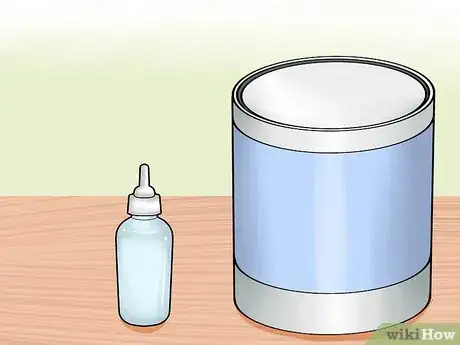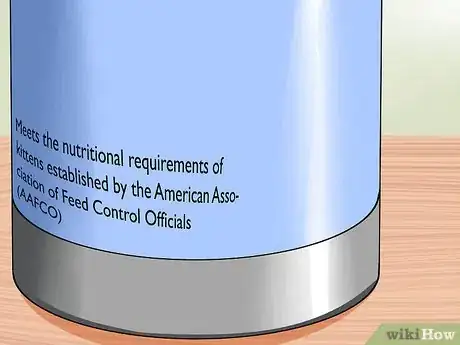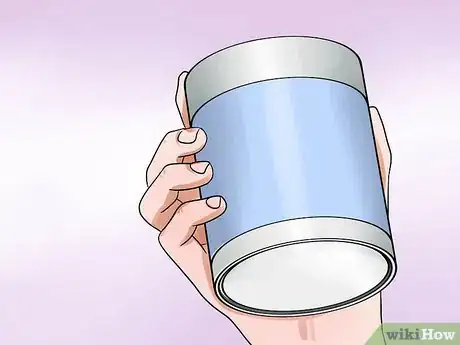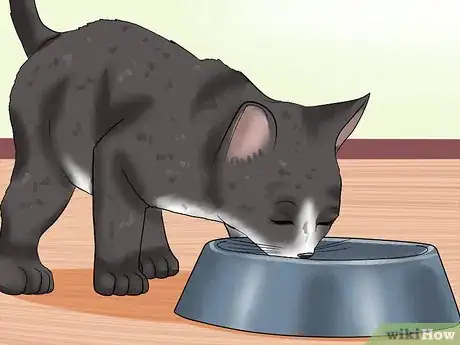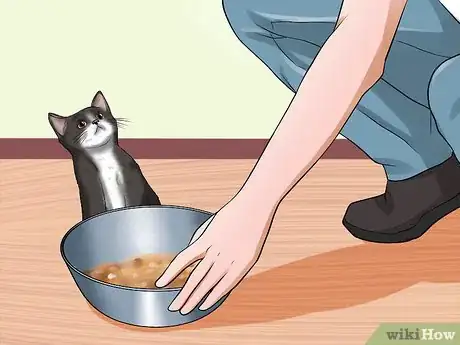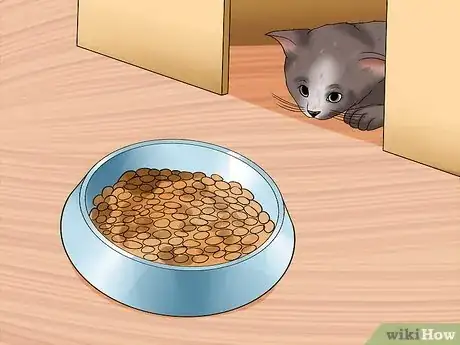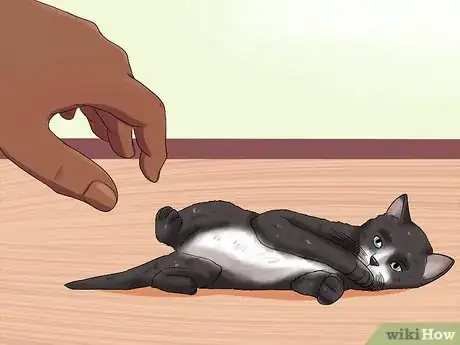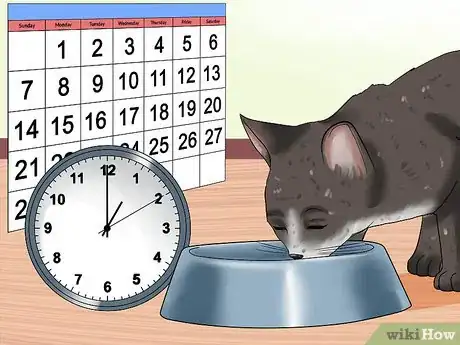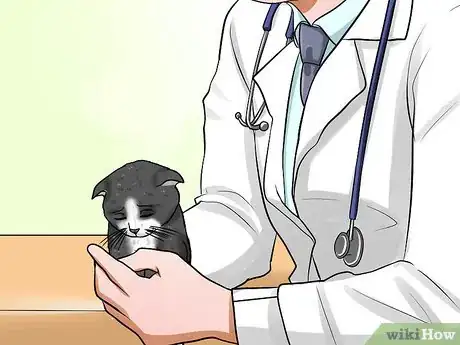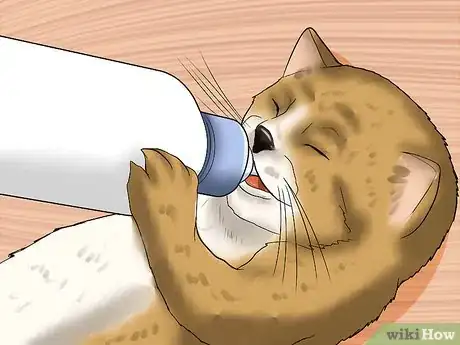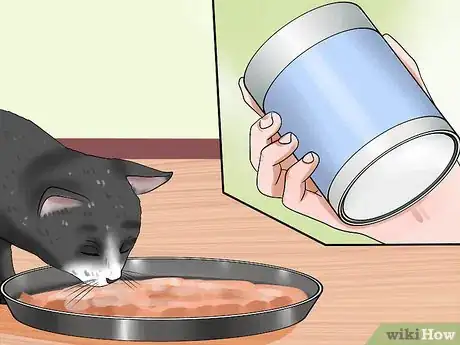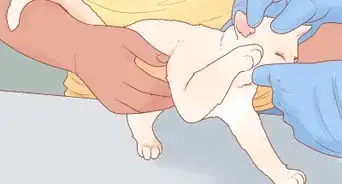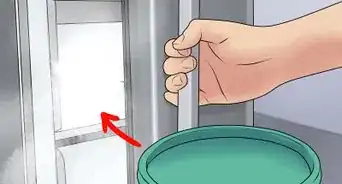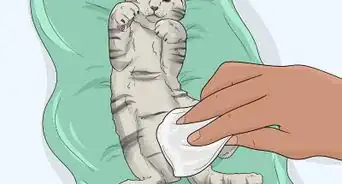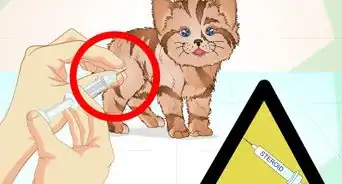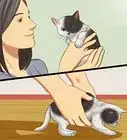This article was co-authored by Pippa Elliott, MRCVS. Dr. Elliott, BVMS, MRCVS is a veterinarian with over 30 years of experience in veterinary surgery and companion animal practice. She graduated from the University of Glasgow in 1987 with a degree in veterinary medicine and surgery. She has worked at the same animal clinic in her hometown for over 20 years.
There are 8 references cited in this article, which can be found at the bottom of the page.
This article has been viewed 29,827 times.
Kittens double or triple their weight during the first few weeks of life. To grow at a steady pace, they need food that contains the right balance of protein, vitamins, and minerals. If your kitten is still nursing, you'll need to help it make the transition from milk to solid foods. Making sure you meet your kitten's dietary needs will enable it to grow into a strong, healthy cat.
Steps
Choosing Healthy Food
-
1Get kitten milk replacement formula if your kitten is under 3 weeks old. During the first few weeks after birth, kittens get all their essential nutrients from their mothers' milk. A kitten that's 1 month old or younger is unable to digest or excrete solid food. If you have a kitten who has not yet been weaned (the process of changing from milk to solid food), you'll need a product called kitten milk replacement to help it make the transition.
- If your kitten's mother is part of your household, it will provide all the milk your kitten needs. Having milk replacement on hand can still be convenient when you need to start getting the kitten used to solid foods. You can mix the milk replacement with solids to soften their texture a little.
- If your kitten is still very young and has already been taken away from its mother, you will need to bottle-feed it until she's old enough to eat solid foods. It is essential that you get kitten milk replacement to meet its nutritional needs. Cow milk is not a good substitute.
- Call a veterinarian and ask for kitten formula recommendations. The formula typically comes in a powdered form that you mix with water. Top brands include PetAg KMR® Powder and Farnam Pet Products Just Born® Highly Digestible Milk Replacer for Kittens.[1]
-
2Buy solid food formulated especially for kittens. If your kitten is over 4 weeks old, it's time to start feeding it solids. It is important to choose food made for kittens, not cats. Since kittens grow so quickly in the first few months of their lives, they have different nutritional needs than cats. Feeding a kitten cat food will result in the kitten becoming weak or sick.
- Kitten food is usually labeled with terms like "kitten formula" or "kitten growth formula" to help you distinguish it from cat food.
- The ASPCA recommends feeding a kitten special kitten food until it reaches the age of 1 year old. At that time, you may switch to regular cat food.[2]
Advertisement -
3Pick a high-quality brand. Most veterinarians don't recommend buying generic or store-brand pet foods. It's better to buy a quality brand of kitten food that comes highly recommended because the effectiveness of name brands is usually backed by research. If you're not sure what brand to choose, call a veterinarian and ask.[3]
- Check the packaging for this statement: "Meets the nutritional requirements of kittens established by the American Association of Feed Control Officials (AAFCO)." Avoid brands that don't carry this statement.
- You can also look for this statement. It is found on the highest-quality products: “Complete and balanced nutrition for kittens based on AAFCO feeding trials.”
-
4Choose both dry and canned food. Since kittens aren't able to chew as well as full-grown cats, they need soft food in addition to dry. Both canned and dry foods should be formulated especially for kittens, not cats. For canned foods, make sure to check the expiration date and avoid buying dented or damaged cans.[4]
-
5Feed the kitten occasional "people food" snacks. Kittens need fat, fatty acids, calcium, protein, and many other nutrients to grow healthy and strong. Kitten food meets these requirements, so it should make up the majority of your kitten's food intake. If you want to feed your kitten extra treats, they should make up no more than 10 percent of your kitten's total calorie intake. Cooked slices of meat, chicken or fish are usually fine choices. Avoid feeding your kitten the following:[5]
- Raw meat, eggs, or fish, which may contain parasites or harmful bacteria
- Milk or cream, which can cause diarrhea
- Onions, garlic, chocolate, coffee, tea, raisins, and grapes, which are toxic to cats
Starting a Feeding Routine
-
1Have the kitten drink milk or milk replacement for the first 4 weeks. Kittens who are not weaned need a milk-only diet. Don't try to introduce solids until the kitten is over 4 weeks old. If the kitten is still with its mother, the mother will do everything necessary to make sure the kitten is getting the milk it needs. If the mother is not there, you will need to bottle feed the kitten. To bottle-feed a kitten, follow these steps:
- Kittens under 4 weeks old must be fed every 3 hours around the clock (including at night). Purchase kitten milk replacement formula and a bottle designed for feeding a kitten. These are available at your vet's office or a pet store.
- Make sure the kitten is adequately warm before feeding it. If the kitten is cold or chilled, it won’t be able to digest the milk.
- Sterilize the bottle and nipple by boiling them in water for 5 minutes and allowing them to fully dry.
- Mix the formula according to the manufacturer's instructions.[6] Warm it up in a pan on the stove to reach 95–100 °F (35–38 °C). Test a drop on your wrist to make sure it isn't too hot or cold.[7]
- Place the nipple in the kitten's mouth. Let the kitten drink until it’s full.
- Kittens this young can't urinate or defecate on their own. You must stimulate the kitten's genitals by turning the kitten on her side and rubbing her genitals in one direction until no more urine comes out.[8] This must be done a few minutes after every feeding.
-
2Wean the kitten and introduce solids. When a kitten is ready to wean, it will begin biting at her mother's nipple or the nipple on the bottle you use to feed it. This usually happens when it is about 4 weeks old. At this time, you can begin introducing solids to its diet.[9]
- Place a small amount of food in a food dish for the kitten. If the kitten doesn't seem ready to chew the food, mix in a few tablespoons of milk replacement formula or water to soften the food.
- Gradually reduce the amount of milk offered as you increase the amount of solids offered. The pace at which a kitten is weaned is different for each kitten. Be patient and monitor how much solid food it eats. If the kitten isn't with its mother, offer milk replacement formula until she starts refusing the bottle.
- By 7 weeks, most kittens will be ready for a solids-only diet.
-
3Leave food out at all times. Kittens like to eat small portions of food often throughout the day. While it's possible to enforce a feeding schedule, it's not necessary to do so until your kitten is fully grown. Leave a dish of dry food and a dish of canned food out for your kitten to snack on whenever it wants. Be sure to replace uneaten food with fresh food once a day.[10]
- Don't forget to leave out a dish of water at all times, too.
- At this point you can introduce occasional treats, such as slices of cooked chicken. Be sure treats make up less than 10 percent of the kitten's calorie intake.
-
4Watch your kitten's energy level and weight. If your kitten seems low energy, is gaining too much weight, or seems to thin, there may be a problem with the food. It's important to pay attention to signs that your kitten may not be getting the nutrition it needs.[11]
- If your kitten seems to dislike its food, and rarely eats it, it might not like the taste. Try switching to another flavor or brand.
- If your kitten won't eat, or if it eats too much and becomes obese, make an appointment with the veterinarian to assess the problem.
-
5Switch to a feeding schedule after 1 year. When your kitten turns 1 year old, she's ready for adult cat food and an adult feeding schedule. Begin offering food twice a day, once in the morning and once in the evening. During other times of day, remove the food and offer water only. This will keep your cat healthy and prevent her from becoming obese.[12]
- Some vets recommend switching cats to adult food after they turn 6 months old if they’re desexed or start putting on too much weight.
Feeding a Stray Kitten
-
1Think twice before moving a stray kitten. If you see a stray kitten, your first impulse might be to scoop it up and take it inside to keep it safe. A young kitten's best chance for survival is staying close to its mother, who can provide it with nourishing food and protection. Instead of taking the kitten inside right away, wait and see if the mother is still nearby.
- Keep an eye on the kitten for the next several hours to see if the mother returns. If you need to move the kitten, move it to a safe area that's not too far from where you originally found it.
- If the mother returns, you can offer it food and outdoor shelter so it can safely nurse its kitten (or kittens, as the case may be). After the kitten is weaned, you can consider adopting it. See How to Adopt a Stray Cat for more information.
- If the mother does not return, you'll need to take steps to rescue the kitten.
-
2Take the kitten to the vet. The vet will help you determine whether the kitten is still nursing, as well as assessing the kitten's overall health. It's important to take the kitten to the vet before you take it into your home. Have the kitten checked for fleas and ticks before bringing it home.
-
3Bottle-feed the kitten if necessary. If the vet has determined that the kitten is still young enough to nurse, you'll need to bottle-feed it until it’s ready for solid foods. You'll be able to get the instructions, equipment and milk substitute you need from the vet's office or a recommended pet supply store. Keep the following general guidelines in mind:
- Kittens under 4 weeks old must be fed every 3 hours around the clock (including at night). Feed the kitten milk replacement formula from a bottle. [13]
- Kittens this young can't urinate or defecate on their own. You must stimulate the kitten's genitals by turning the kitten on her side and rubbing her genitals in one direction until no more urine comes out.[14] Do this a few minutes after every feeding.
-
4Introduce solids and wean the kitten. When the kitten is over 4 weeks old, it’s ready for solid food. Be sure to provide high-quality kitten food, both dry and canned, as you wean the kitten from its milk-only diet. Leave food out at all times so the kitten can eat at its leisure, and always provide fresh water as well. Do not provide adult cat food until the kitten is over 1 year old.
Warnings
- Don't give kittens cows milk, as it's not good for them. Instead, buy kitten milk.⧼thumbs_response⧽
- Don't feed kittens adult cat food.⧼thumbs_response⧽
References
- ↑ http://www.animalalliancenyc.org/wordpress/2013/05/what-to-do-and-not-do-if-you-find-a-newborn-kitten/
- ↑ http://pets.thenest.com/harmful-kitten-eat-adult-cat-food-9008.html
- ↑ http://pets.webmd.com/cats/guide/feeding-your-kitten-food-and-treats
- ↑ http://pets.webmd.com/cats/guide/feeding-your-kitten-food-and-treats
- ↑ http://pets.webmd.com/cats/guide/feeding-your-kitten-food-and-treats?page=3
- ↑ http://www.animalalliancenyc.org/wordpress/2013/05/what-to-do-and-not-do-if-you-find-a-newborn-kitten/
- ↑ http://www.nycferalcat.org/BottleFeedingKittens-Letter.pdf
- ↑ http://www.nycferalcat.org/BottleFeedingKittens-Legal.pdf
- ↑ http://www.petmd.com/cat/centers/kitten/nutrition/evr_ct_kitten_feeding_schedule#
- ↑ http://www.aspca.org/pet-care/cat-care/nutrition-tips-kittens
- ↑ http://www.petmd.com/cat/centers/kitten/nutrition/evr_ct_kitten_feeding_schedule#
- ↑ http://pets.webmd.com/cats/guide/feeding-your-kitten-food-and-treats?page=3
- ↑ http://www.animalalliancenyc.org/wordpress/2013/05/what-to-do-and-not-do-if-you-find-a-newborn-kitten/
- ↑ http://www.nycferalcat.org/BottleFeedingKittens-Legal.pdf
About This Article
To feed kittens, feed them kitten milk replacement formula if they're under 4 weeks and have been separated from their mother. Feed them every 3 hours, warming up the formula, putting it in a bottle, then placing the nipple in the kitten’s mouth. After 4 weeks, start providing solid food formulated specifically for kittens, making it available at all times. If they don’t gobble up the solid food, mix in a little bit of kitten formula. By 7 weeks, they should be eating a solids-only diet. To learn how to make sure you’re getting the right foods for your kitten’s needs, scroll down!
